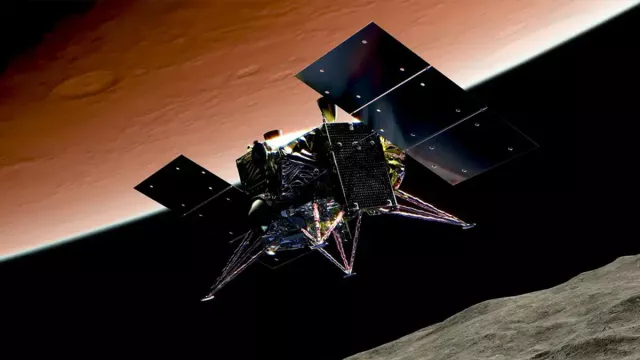The MMX (Martian Moons eXploration) mission led by Japan will lift off in 2026 to study Mars’ two moons, Phobos and Deimos. As well as conducting prolonged scientific investigations, the robotic probe will have the capability to bring back samples from Phobos and deploy a French-German rover on its surface.
Key information
Key figures
- 100-day mission for IDEFIX rover
- 2-cm sampling depth
- 10 g: minimum sample mass
- 12 instruments on spacecraft
Key milestones
- July 2031: Phobos samples return to Earth in Australian desert
- November 2030: Earth return module separates from spacecraft
- Summer/Autumn 2030: End of close observation of Phobos and multiple flybys of Deimos
- Early and mid-2029: Sample collection on Phobos
- December 2028: CNES/DLR’s IDEFIX rover released
- September 2027: MMX goes into orbit around Phobos
- August 2027: MMX goes into orbit around Mars
- October 2026: MMX launched from Tanegashima, Japan
- 9 June 2015: JAXA announces MMX mission
Project in brief
Despite several attempts over the past decades, Phobos and Deimos—Mars’ two small moons—are yet to be studied in detail. Scientists are still debating their origin: Are they the result, like our own Moon, of a giant impact between Mars and another celestial body in the primeval solar system, or are they asteroids captured into the red planet’s orbit? The Japan Aerospace Exploration Agency (JAXA) is undertaking the MMX mission to answer this question, gain new insights into Phobos and Deimos and understand how they formed and evolved.
MMX consists of three separate modules, each with a specific purpose. After lifting off from Japan in October 2026, the propulsion module will convey the other two to Mars’ moons in less than a year. The second module is composed of a robotic probe and a small French-German rover. The probe will land on Phobos to collect 10 grams of material after surveying it from a quasi-orbit. Once it has set down the rover and obtained samples on Phobos, the probe will execute a series of flybys of the smaller moon Deimos. It will then release the third module to bring the samples back to Earth inside a return capsule in 2031.
The main mission will be carrying a suite of 13 scientific instruments (including the rover), with the goal of mapping and characterizing the moons’ surfaces at high resolution in order to determine their chemical and mineralogical make-up, as well as observing storms and clouds on Mars. The MIRS instrument (MMX InfraRed Spectrometer), for which the LESIA space and astrophysics instrumentation research laboratory is prime contractor, will characterize the moons’ mineral composition and analyse Mars’ atmosphere. It will also help teams to select landing sites for MMX.
CNES’s role
In partnership with JAXA, CNES is contributing to the MMX mission in three ways. First, it is studying flight trajectories and dynamics for the cruise phase and will possibly be involved in flight operations. Second, it is involved in the mission’s science with the MIRS near-infrared imaging spectrometer on the robotic probe. And third, it is working with teams at the German space agency DLR to build the IDEFIX rover and its four instruments that will attempt the unique feat of driving on Phobos, where gravity will be some 1,800 times weaker than on Earth.
As it is contributing to the MMX mission, France will be receiving a share of samples returned to Earth for analysis by its scientific community. To this end, a curation centre will be developed at the National Natural History Museum.
Contacts
MIRS Project Leader
Christophe DONNY
E-mail: christophe.donny at cnes.fr
IDEFIX rover Project Leader
Julien BAROUKH
E-mail: julien.baroukh at cnes.fr
Spaceflight Dynamics Project Leader
Elisabet CANALIAS
E-mail: elisabet.canalias at cnes.fr
Solar System Planets & Small Bodies subject matter expert
Francis ROCARD
E-mail: francis.rocard at cnes.fr



